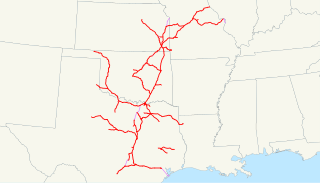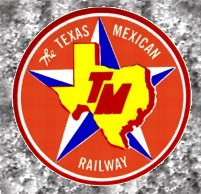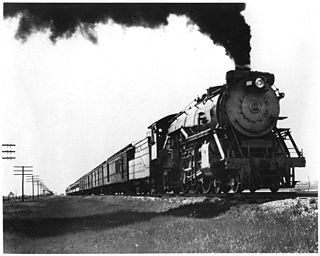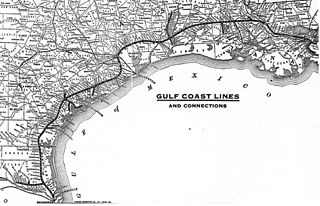

The Abilene and Southern Railway was a railroad company that existed from 1909 to 1978 and was eventually taken over by the Missouri Pacific Railroad.


The Abilene and Southern Railway was a railroad company that existed from 1909 to 1978 and was eventually taken over by the Missouri Pacific Railroad.
The Abilene and Southern Railway Company was founded on January 13, 1909, in Abilene, Texas by Morgan Jones (1839-1926). Jones proposed to construct 150 miles (240 km) of railroad. [1] Construction work started soon and on April 23, 1909, the first official train ran the eight miles (12.9 km) from Abilene to Iberis, Texas. From September 11 the same year, the road was operating from Abilene to Ballinger, Texas, a total of 54.75 miles (88.11 km), where a connection to a branch line of the Gulf, Colorado and Santa Fe Railway was established. Finally, on October 1, 1910, a railroad from Anson, Texas to Hamlin, Texas (17.41 miles (28.02 km)) was opened. Plans for further extensions to Sonora and San Angelo, Texas were dropped soon thereafter. Between Abilene and Anson (24.62 miles (39.62 km)), the Abilene & Southern used existing tracks built in 1907 by the Abilene and Northern Railway and meanwhile operated by the Colorado and Southern Railway. The total trackage used by the Abilene & Southern was 96.78 miles (155.75 km).
On April 25, 1927, the Texas and Pacific Railway was authorized by the Interstate Commerce Commission to buy the entire stock of the Abilene & Southern which continued to operate the road. The ICC allowed abandonment of the Anson–Hamlin track including the end of the trackage rights over the railroad from Abilene to Anson on January 9, 1937, and in February that year operations north of Abilene ceased. The stretch from Winters to Ballinger (16 miles (26 km)) lost rail traffic in 1972 and was torn up. In 1976 the Texas & Pacific merged with the Missouri Pacific Railroad and the Abilene & Southern ceased to exist on November 1, 1978, [2] when it was also merged with the Missouri Pacific. The remaining railroad from Abilene to Winters was later abandoned.
Before the railroad to Hamlin was opened, there was one daily train from Abilene to Ballinger. [1] With the new road, a second train, running daily except Sunday from Hamlin to Ballinger, was inaugurated. [3] Passenger trains ceased to use the Colorado & Southern trackage between Abilene and Anson during World War I and the Hamlin train now ran only between Anson and Hamlin. [4] Later the link was reestablished and the Hamlin train now ran to Abilene, but the Abilene–Ballinger train was dropped on Sundays. In 1926, both trains operated as mixed train s. [5] In December 1941 regular passenger service ended. The mixed train now ran on irregular schedule subject to freight connections. [6] This lasted until May 1957 when the line became freight-only.

The Denver and Rio Grande Western Railroad, often shortened to Rio Grande, D&RG or D&RGW, formerly the Denver & Rio Grande Railroad, was an American Class I railroad company. The railroad started as a 3 ft narrow-gauge line running south from Denver, Colorado, in 1870. It served mainly as a transcontinental bridge line between Denver and Salt Lake City, Utah. The Rio Grande was also a major origin of coal and mineral traffic.
Hamlin is a city in Jones and Fisher Counties in the U.S. state of Texas. The population was 1,831 at the 2020 census. The Jones County portion of Hamlin is part of the Abilene, Texas metropolitan area.

BNSF Railway is the largest freight railroad in the United States. One of six North American Class I railroads, BNSF has 36,000 employees, 33,400 miles (53,800 km) of track in 28 states, and over 8,000 locomotives. It has three transcontinental routes that provide rail connections between the western and eastern United States. BNSF trains traveled over 169 million miles in 2010, more than any other North American railroad.

The Missouri–Kansas–Texas Railroad was a Class I railroad company in the United States, with its last headquarters in Dallas, Texas. Established in 1865 under the name Union Pacific Railroad (UP), Southern Branch, it came to serve an extensive rail network in Texas, Oklahoma, Kansas, and Missouri. In 1988, it merged with the Missouri Pacific Railroad; today, it is part of UP.

The Missouri Pacific Railroad, commonly abbreviated as MoPac, was one of the first railroads in the United States west of the Mississippi River. MoPac was a Class I railroad growing from dozens of predecessors and mergers. In 1967, the railroad operated 9,041 miles of road and 13,318 miles of track, not including DK&S, NO&LC, T&P, and its subsidiaries C&EI and Missouri-Illinois.

The St. Louis Southwestern Railway Company, known by its nickname of "The Cotton Belt Route" or simply "Cotton Belt", was a Class I railroad that operated between St. Louis, Missouri, and various points in the U.S. states of Arkansas, Tennessee, Louisiana, and Texas from 1891 to 1980, when the system added the Rock Island's Golden State Route and operations in Kansas, Oklahoma, and New Mexico. The Cotton Belt operated as a Southern Pacific subsidiary from 1932 until 1992, when its operation was assumed by Southern Pacific Transportation Company.

The Missouri & Northern Arkansas Railroad, LLC is a Class II Regional Railroad in the U.S. states of Missouri, Kansas, and Arkansas. The company is headquartered in Carthage, Missouri. It is not to be confused with the Missouri and North Arkansas Railroad which connected Joplin, Missouri, with Helena, Arkansas, from 1906 to 1946.

The Texas Mexican Railway was a short line railroad in the U.S. state of Texas operating between Corpus Christi and the Texas Mexican Railway International Bridge in Laredo, Texas. It is often referred to as the Tex-Mex, or TexMex Railway.
The Kansas, Oklahoma and Gulf Railway (“KO&G”) had at its height 310.5 miles of track from Denison, Texas through Oklahoma to Baxter Springs, Kansas. Its various predecessor companies built the line between 1904 and 1913. The railroad was consolidated into a Missouri Pacific Railroad subsidiary—the Texas and Pacific Railway—in 1963.

The Fort Worth and Denver Railway, nicknamed "the Denver Road," was a class I American railroad company that operated in the northern part of Texas from 1881 to 1982, and had a profound influence on the early settlement and economic development of the region.

The Texas and New Orleans Railroad was a railroad in Texas and Louisiana. It operated 3,713 miles (5,975 km) of railroad in 1934; by 1961, 3,385 miles (5,448 km) remained when it merged with parent company Southern Pacific.
The Oklahoma, Kansas and Texas Railroad (OKT) was a railroad operating in its namesake states in the 1980s.

The Cadillac & Lake City Railway was a railroad which operated in the Midwestern United States. The operation was owned by Western States Properties, Inc. and several investors who operated lines in three states; Colorado, Kansas, and Michigan during its time.
The Burlington-Rock Island Railroad came into existence on July 7, 1930, through the reorganization of its predecessor, the Trinity and Brazos Valley Railway Company (T&BV), nicknamed the "Boll Weevil Line."

The Alabama Great Southern Railroad is a railroad in the U.S. states of Alabama, Georgia, Louisiana, Mississippi, and Tennessee. It is an operating subsidiary of the Norfolk Southern Corporation (NS), running southwest from Chattanooga to New Orleans through Birmingham and Meridian. The AGS also owns about a 30% interest in the Canadian Pacific Kansas City-controlled Meridian-Shreveport Meridian Speedway.
The Central Midland Railway, a division of Progressive Rail Incorporated of Lakeville, Minnesota, was a short line railroad in the U.S. state of Missouri, operating under lease of the former St. Louis Subdivision of the Chicago, Rock Island and Pacific Railroad. CMR operated the easternmost 60 miles (97 km) of the 298-mile (480-km) Rock Island line which used to stretch from St. Louis to Kansas City, Missouri. CMR's operation of the line was performed under two separate leases from the Union Pacific Railroad and the A&K Railroad Materials Corp, respectively, from Overland, Missouri - a suburb of St. Louis, to a location just west of Union, Missouri. CMR's first leased-segment was Union Pacific's "Lackland Subdivision" which extends from "Rock Island Junction" near the intersection of Page Avenue and I-170 in Overland to a location on the north-side of Creve Coeur Lake in Maryland Heights, Missouri, known as "Vigus." The second leased-segment was owned by A&K Railroad Materials and extends from Vigus to just east of Beaufort, Missouri, with active service terminating at Union.

The Gulf Coast Lines was the name of a railroad system comprising three principal railroads, as well as some smaller ones, that stretched from New Orleans, Louisiana, via Baton Rouge and Houston to Brownsville, Texas. Originally chartered as subsidiaries of the Frisco Railroad, the system became independent in 1916 and was purchased by the Missouri Pacific Railroad in 1925.

The Trinity and Brazos Valley Railway of Texas came into existence on October 7, 1902, originally chartered to build a railroad from Johnson County to the Beaumont area near the Gulf coast. It took its name from the Trinity and Brazos rivers. It was commonly known as the “Boll Weevil," though it referred to itself as the "Valley Road."

Union Station is a building in Houston, Texas, in the United States. Dedicated on March 2, 1911, and formerly a hub of rail transportation, the building now serves as a cornerstone for Minute Maid Park. It is listed on the National Register of Historic Places, and has since been superseded by Houston's Amtrak station.
The Texas and Oklahoma Railroad (TXOR), created in 1991, ran between Oklahoma and Texas on rail purchased from the Atchison, Topeka and Santa Fe Railway (AT&SF). Much of the trackage has since been sold or abandoned; however, the railway continues to exist as a shortline carrier operating between Sweetwater, Texas and Maryneal, Texas.